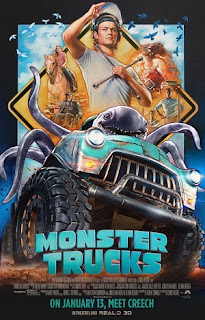Time for that annual list of the movies that, at this particular
highly subjective moment, seem like my ten favorites of the year:
Moonlight—This
naturalistic coming-of-age story from director Barry Jenkins about an
African-American kid in Miami’s Liberty City and his subsumed sexual identity,
among other struggles, inspires a litany of adjectives: Heartbreaking,
harrowing, tender, beautiful, thoroughly original.
Manchester by the Sea—There’s
an unbearable tragedy at the center of this New England
drama, but as usual writer-director Kenneth Lonergan seems incapable of hitting
a false note, the long-underrated Casey Affleck is superb in the lead, and
Michelle Williams is unforgettable in her big scene.
Florence Foster
Jenkins—Heaping praise on Meryl Streep started getting old three decades
ago, but when she keeps offering up beguilingly silly work like this portrait
of the Manhattan
wannabe soprano, what else can you do? Hugh Grant is also at his best in this,
as is supporting player Simon Helberg and director Stephen Frears.
The Eagle Huntress—Whether
or not it strictly qualifies as a documentary, Otto Bell’s chronicle, full of
engaging non-actors using their real names, of a Mongolian Kazakh teenage girl
breaking into the traditionally male field of eagle hunting is one-of-a-kind
and exhilarating.
Paterson—Jim
Jarmusch’s New Jersey idyll, about a week in the life of a bus driver and
contentedly unknown poet, is suspiciously rose-colored in its view of the
heartsease of an artist with a working life. But it’s such a serene fantasy,
and Adam Driver is so sweet in the lead, that you’re likely to be drawn in.
Hell or High Water—This
tight, pissed-off, grimly funny Texas
noir features maybe the best use of the “cop about to retire” cliché ever. The
four leads are outstanding: Chris Pine as a desperate small-potatoes bank
robber, Ben Foster as his cheerfully nihilistic brother and partner, and Jeff
Bridges and Gil Birmingham as the Texas Rangers hunting them.
Loving—A hushed,
restrained, moving portrait of the people behind 1967’s famous Loving v. Virginia Supreme Court
decision, which declared interracial marriage a constitutional right. Joel
Edgerton and Ruth Negga are quietly superb in the leads.
Dr. Strange—Of this
year’s big-studio blockbusters, this origin story for Marvel’s cheeky
metaphysician may have been the most enjoyable. Benedict Cumberbatch is just
right in the title role, Tilda Swinton is a delight as The Ancient One, and the
production is polished and impressive.
Star Trek: Beyond—On
the other hand, this latest entry in the rebooted Trek franchise was also a lot of fun. It will never replace the
original for me, but on its own terms, it’s pretty rollicking.
Morris From America—Another
coming-of-age tale, this one a bit lighter: the hero is a 13-year-old aspiring
American rapper stuck in Germany
with his single father. Markees Christmas and Craig Robinson are terrific as
son and father.
Here are some others I’m not sorry I saw: Christine (excellent but painfully
depressing), De Palma (made me want
to watch a bunch of his movies), Miss
Hokusai (Japanese historical anime; would have made the Top Ten but imdb
says it’s a 2015 movie), The Edge of
Seventeen, Fences, Zootopia, Don’t Breathe, Love &
Friendship, Rogue One, Sully, Trolls, The Love Witch, Max Rose, The Hollars, Fantastic Beasts
and Where to Find Them, City of Gold,
Queen of Katwe, Anthropoid, Bad Santa 2, The Bronze, 10 Cloverfield Lane, The
Lobster, Green Room, The Jungle Book, The Shallows, Hidden Figures,
Finding Dory, Life,
Animated and the maligned new version of Ghostbusters.
Also, A Monster Calls, which opens tomorrow. So…
Monster-of-the-Week: …let’s give the nod to the title
character of the 2011 book upon which that movie is based, seen here…
…as rendered in the award-winning illustrations of Jim Kay.




























